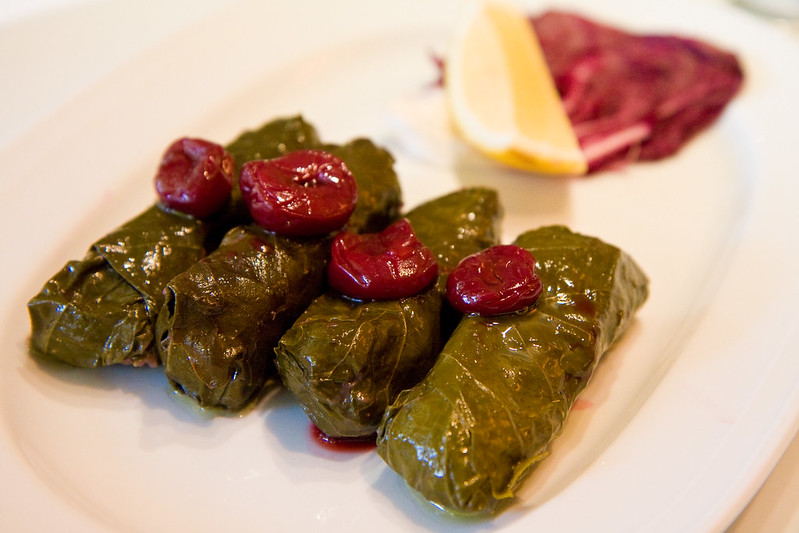Vegetables are consumed in large quantities in the Turkish diet. A whole class of vegetables is cooked in olive oil. If a dish is cooked without any kind of meat then its called zeytin yağlı – meaning cooked with olive oil.
These kind of vegetables are mostly served cold. Dolma is the most famous olive oil dish. Vegetables, consumed either fresh or dried include eggplants, peppers, tomatoes and zucchinis. They are stuffed with a mixture of rice and onion with various spices. Yaprak Sarma is most common and most delicious olive oil dish. Wrapped vine leaves are filled with rice, onion and spices like mint, currant, pepper and cinnamon. When it comes to vegetables, in Turkish Cuisine the eggplant is the first vegetable that comes to mind. Eggplant has a special place in Turkey. Discussion of how to cook eggplant could be a topic for a whole night of discussion. İmam Bayıldı, Ali Nazik, and Musakka are the most famous eggplant dishes.

Vişneli Yaprak Sarma by Garrett Ziegler
Cucumber (Salatalık): It is eaten by itself or used in pickles and salads. Although it is raised throughout Turkey, various varieties are preferred in different regions, each with its own flavour. In Istanbul, the most famous varieties are Çengelköy (neighbourhood of Üsküdar) and Langa.
Arugula (Roka): Its leaves are made into salad. It’s frequently used as a garnish.
Asparagus (Kuşkonmaz): It’s commonly eaten raw and also used in soup and salads.
Artichoke (Enginar): It’s mostly known in Aegean region and Istanbul. Prepared in “olive oil” dishes with celeriac and its classified as a meze.
Cabbage (Lahana): There are many varieties. White and red cabbage are the most common. The wide leaves are ideal for stuffing but also used in other main dishes and soup. Red cabbage is only used in salads.
Carrot (Havuç): Is used as an ingredient in other dishes and also made into salads and pickles.
Cauliflower (Karnabahar): It is cooked with tomato sauce and ground meat, and is mostly consumed in western Turkey.
Celeriac (Kereviz): In Turkish cuisine, celeriac is most popular in the west and in Istanbul, where it is cooked in a meat dish as well as served cold as an “olive oil” dish.
Garlic (Sarımsak): Garlic is very popular in Turkish cooking for its special aroma and flavour, and is consumed at all stages, from green “scallion” stage to fresh bulb to mature/dry. In its dry form it also adds sweetness to a dish. It is also frequently used in pickles.
Leeks (Pırasa): Traditionally used in both “olive oil” dishes as well as meat dishes, it has recently begun to be used in new and original ways in Turkish cuisine.
Mushrooms (Mantar): With tens of thousands of species in nature, mushrooms are commonly cultivated today. Mushrooms are technically not a plant, they are a fungus. With its many varieties, Turkey could be considered a mushroom paradise. Although there are many different ways of preparing them, the most common method in Anatolia is to cook them directly over a flame or coals, accompanied only with salt and black or red pepper. They are also cooked in meat or vegetarian dishes as well as used in pilaf and salads.
Okra (Bamya): It should be picked when young, because the pods toughen as they mature. In Turkish cuisine it is used both fresh and dried in meat and “olive oil” dishes.
Onions (Soğan): It is one of the fundamental vegetables in Turkish cooking, adding sweetness to dishes for years. It is used at all stages, from scallions to green bulbs to the familiar dried vegetable. All stages may be used in cooked dishes, pilaffs, salads and kebab.
Parsley (Maydanoz): Its leaves are used as a flavouring herb. In Turkish cooking, parsley is utilized more as a secondary ingredient than a vegetable in and of itself. It is eaten plain or added to provide flavour and aroma to cooked dishes as well as salads.
Peppers (Biber): Many different varieties are raised in Turkey. The edible part is the seed pod, which is green when unripe and turns red when ripe. The veins and the seeds are generally hot. Peppers are raised almost everywhere in Turkey, with many different varieties and names reflecting a variety of shapes and uses: Sivri (pointed), Çarliston, Süs (decoratıve), Domates (tomato), Ayaş (place name), Dolmalık (stuffing), and red pepper. In southern Anatolia it is finely chopped and made into paste.
Potatoes (Patates): Several varieties of potatoes are grown in Turkey, and potatoes are frequently used in Turkish dishes.
Purslane (Semizotu): It is used in cooked dishes as well as in fresh salads. In Anatolia, the wild form is commonly used, but there is also a large-leaved cultivated form commonly available as well.
Spinach (Ispanak): It is raised in many parts of Turkey and is cooked alone or with ground meat. It is also used in dishes like ıspanak kavurması, spinach with eggs and spinach börek.
Radish (Turp): The edible root may be red, black, white or yellowish. It is generally used to accompany dishes rather than actually being cooked as a dish by itself. One type is used to add sweetness.
Tomatoes (Domates): It is said to have entered Turkish cuisine only about 100 years ago, but it has a major place in Turkish cooking. It is used fresh in salads but it also adds flavour to many cooked dishes. In addition to ripe red tomatoes, green and yellow tomatoes are also used in Turkish cooking; in pickling for example. It is also used in paste form in a great many regions.
Turnips (Şalgam): It is not used much as a food in Turkey; it is better known as the main ingredient of a pickled drink by the same name. Made in the Çukurova (Adana) region, Şalgam is known to enhance the appetite, and is often drunk alongside rakı.
